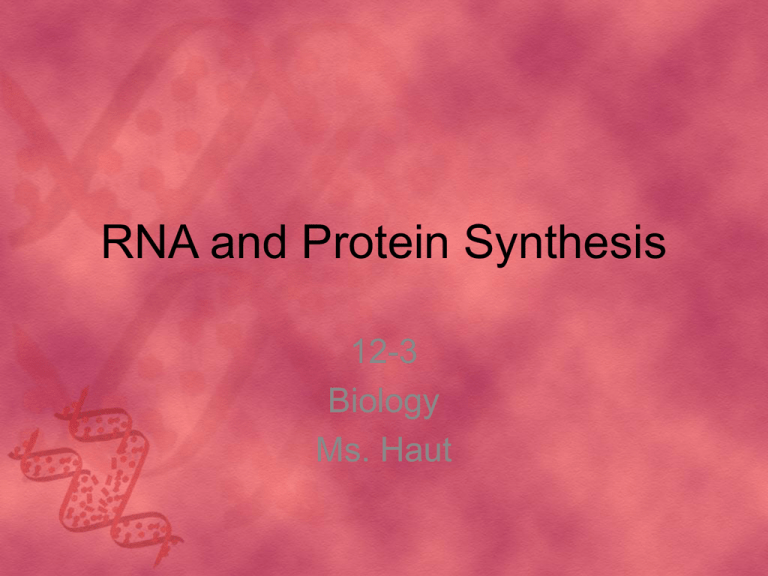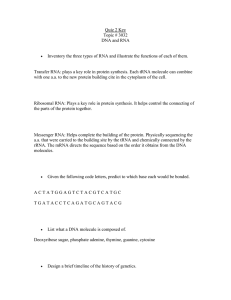RNA and Protein Synthesis 12-3 Biology Ms. Haut
advertisement

RNA and Protein Synthesis 12-3 Biology Ms. Haut Flow of Genetic Information • Flow of genetic information from DNA to RNA to protein • The DNA genetic code (genotype) is expressed as proteins which provide the physical traits (phenotype) of an organism GCTGCTAACGTCAGCTAGCTCGTAGC GCTAGCGCTTGCGTAGCTAAAGTCGA GCTCGCTTGCGTAGCTAAAGTCGAGC TGCTGCTAACGTCAGCTAGCTCGTAG AGCGCTTGCGTAGCTAAAGTCGAGCT AGCGCTTGCGTAGCTAAAGTCGAGCT GCTGCTAACGTCAGCTAGCTCGTAGC AGCGCTTGCGTAGCTAAAGTCGAGCT AGCGCTTGCGTAGCTAAAGTCGAGCT GCTGCTAACGTCAGCTAGCTCGTAGC AGCGCTTGCGTAGCTAAAGTCGAGCT AGCGCTTGCGTAGCTAAAGTCGAGCT GCTGCTAACGTCAGCTAGCTCGTAGC AGCGCTTGCGTAGCTAAAGTCGAGCT GCTGCTAACGTCAGCTAGCTCGTAGC AGCGCTTGCGTAGCTAAAGTCGAGC, cont. RNA Proteins RNA and Protein Synthesis • Genes are coded DNA instructions that control the production of proteins. • Genetic messages can be decoded by copying part of the nucleotide sequence from DNA into RNA. • RNA contains coded information for making proteins. Copyright Pearson Prentice Hall • RNA consists of a long chain of nucleotides. • Each nucleotide is made up of a 5carbon sugar, a phosphate group, and a nitrogenous base. Copyright Pearson Prentice Hall http://www.phschool.com/science/biology_place/biocoach/images/transcription/chembase.gif The Structure of RNA The Structure of RNA • Three main differences between RNA and DNA: • The sugar in RNA is ribose instead of deoxyribose. • RNA is generally single-stranded; DNA is doublestranded. • RNA contains uracil in place of thymine in DNA. Copyright Pearson Prentice Hall Types of RNA • 3 Types of RNA – messenger RNA (mRNA) – ribosomal RNA (rRNA) – transfer RNA (tRNA) Copyright Pearson Prentice Hall Types of RNA • Messenger RNA (mRNA) carries copies of instructions for assembling amino acids into proteins. Copyright Pearson Prentice Hall Types of RNA • Ribosomes are made up of proteins and ribosomal RNA (rRNA). • Line up mRNA and tRNA Copyright Pearson Prentice Hall Types of RNA • During protein construction, transfer RNA (tRNA) transfers each amino acid to the ribosome. • Each tRNA molecule carries only one kind of amino acid. • Carries the anticodon, complementary to one mRNA codon. Anticodon Copyright Pearson Prentice Hall Protein Synthesis • Transcription Process in which a molecule of DNA is copied into a complementary strand of RNA • Translation Process in which the message in RNA is made into a protein Transcription • RNA molecules are produced by copying part of a nucleotide sequence of DNA into a complementary sequence in RNA. • Transcription requires the enzyme RNA polymerase. • Takes place in the cell’s nucleus. Copyright Pearson Prentice Hall Transcription • During transcription, RNA polymerase binds to DNA and separates the DNA strands. • RNA polymerase uses one strand of DNA as a template to assemble nucleotides into a strand of RNA. Copyright Pearson Prentice Hall Transcription • RNA polymerase binds only to regions of DNA known as promoters. • Promoters are signals in DNA that indicate to the enzyme where to bind to make RNA. Copyright Pearson Prentice Hall Transcription 1. Initiation: • RNA polymerase (enzyme) attaches to DNA at the promoter and “unzips” the two strands of DNA 2. Elongation: • RNA polymerase then “reads” the bases of DNA and builds a single strand of complementary RNA called messenger RNA (mRNA) 3. Termination: • When the enzyme reaches the terminator sequence, the RNA polymerase detaches from the RNA molecule and the gene RNA Editing in Eukaryotes • Sequences that are not involved in coding for proteins are called introns. • The DNA sequences that code for proteins are called exons. • When RNA molecules are formed, introns and exons are copied from DNA. • Introns must be removed and exons spliced together Exon Intron Exon Intron Exon DNA Cap RNA transcript with cap and tail Transcription Addition of cap and tail Introns removed Tail Exons spliced together mRNA Copyright Pearson Prentice Hall Coding sequence NUCLEUS CYTOPLASM The Genetic Code • The genetic code is the “language” of mRNA instructions. • The code is written using four “letters” (the bases: A, U, C, and G). DNA: T A C A G T T C C A G T mRNA: A U G U C A A G G U C A Copyright Pearson Prentice Hall The Genetic Code • A codon consists of three consecutive nucleotides on mRNA that specify a particular amino acid. Copyright Pearson Prentice Hall The Genetic Code • Each codon specifies a particular amino acid that is to be placed on the polypeptide chain. • Some amino acids can be specified by more than one codon. Copyright Pearson Prentice Hall The Genetic Code • There is one codon AUG that can either specify the amino acid methionine or serve as a “start” codon for protein synthesis. • There are three “stop” codons that do not code for any amino acid. These “stop” codons signify the end of a polypeptide. – UAA – UAG – UGA Copyright Pearson Prentice Hall Translation • Translation is the decoding of an mRNA message into a polypeptide chain (protein). • Translation takes place on ribosomes in the cytoplasm of the cell. • During translation, the cell uses information from messenger RNA to produce proteins. Copyright Pearson Prentice Hall Translation • Translation begins when an mRNA molecule attaches to a ribosome starting at the START codon (AUG). • As each codon of the mRNA molecule moves through the ribosome, the proper amino acid is brought into the ribosome by tRNA. • In the ribosome, the amino acid is transferred to the growing polypeptide chain. Copyright Pearson Prentice Hall Translation • The ribosome binds new tRNA molecules and amino acids as it moves along the mRNA. • The growing protein strand separates from the former tRNA and forms a peptide bond with the amino acid on the new tRNA. Copyright Pearson Prentice Hall Peptide bond Translation • The process continues until the ribosome reaches a STOP codon. Reading direction Ribosome 5’ mRNA U U C 3’ UG G A U G U A C Met U G G A C C Trp U U C U GG Incoming tRNA charged with amino acid Ribosome Reading direction 5’ 3’ mRNA U U C UG G A U G U G G A C C Outgoing “empty” tRNA Trp Met U U C A A G Phe U GG Ribosome Reading direction 5’ mRNA U U C 3’ UG G A U G U G G U U C A A G U GG A C C A C C Phe Trp Met Trp Ribosome Reading direction 5’ 3’ mRNA U U C UG G A U G U G G U U C U GG A C C A C C Phe Trp Met Trp Reading direction Ribosome 5’ 3’ mRNA U U C UG G A U G Outgoing “empty” tRNA Met Anticodon A A G A C C Phe Trp Amino acid U G G A C C Trp U U C U GG Incoming tRNA charged with amino acid The Roles of RNA and DNA • The cell uses the DNA “master plan” to prepare RNA “blueprints.” The DNA stays in the nucleus. • The RNA molecules go to the protein building sites in the cytoplasm—the ribosomes. Copyright Pearson Prentice Hall Genes and Proteins • Genes contain instructions for assembling proteins. • Many proteins are enzymes, which catalyze and regulate chemical reactions. • Proteins are each specifically designed to build or operate a component of a living cell. Copyright Pearson Prentice Hall Genes and Proteins • The sequence of bases in DNA is used as a template for mRNA. • The codons of mRNA specify the sequence of amino acids in a protein. Copyright Pearson Prentice Hall Transcribe and Translate the following DNA molecule DNA: T A C A G T T C C A T T mRNA: A U G-U C A-A G G-U A A tRNA: U A C-A G U-U G G-A U U Amino acids: Met-Ser-Arg-Stop The role of a master plan in a building is similar to the role of which molecule? a) b) c) d) messenger RNA DNA transfer RNA ribosomal RNA Copyright Pearson Prentice Hall A base that is present in RNA but NOT in DNA is a) b) c) d) thymine. uracil. cytosine. adenine. Copyright Pearson Prentice Hall The nucleic acid responsible for bringing individual amino acids to the ribosome is a) b) c) d) transfer RNA. DNA. messenger RNA. ribosomal RNA. Copyright Pearson Prentice Hall A region of a DNA molecule that indicates to RNA polymerase where to bind to make RNA is the a) b) c) d) intron. exon. promoter. codon. Copyright Pearson Prentice Hall A codon typically carries sufficient information to specify a(an) a) b) c) d) single base pair in RNA. single amino acid. entire protein. single base pair in DNA. Copyright Pearson Prentice Hall • Stop



